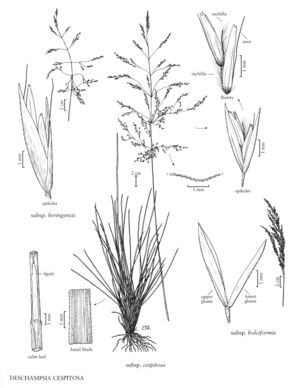Plants usually perennial, sometimes annual; cespitose or tufted. Culms 5-140 cm, hollow, erect. Leaves usually mainly basal, often forming a dense tuft; sheaths open; auricles absent; ligules membranous, decurrent, rounded to acuminate; blades often all or almost all tightly rolled or folded and some flat, sometimes most flat, others rolled or folded. Inflorescences terminal panicles, open or contracted; disarticulation above the glumes, beneath the florets. Spikelets 3-9 mm, with 2 (3) florets in all or almost all spikelets, florets usually bisexual, sometimes viviparous; rachillas hairy, usually prolonged more than 0.5 mm beyond the base of the distal floret, sometimes terminating in a highly reduced floret. Glumes subequal to unequal, usually exceeding the adjacent florets, often exceeding all florets, 1-veined or 3-veined, acute to acuminate; calluses antrorsely strigose; lemmas obscurely (3) 5-7-veined, rounded over the back, apices truncate-erose to 2-4-toothed, awned, awns usually attached on the lower 1/2 of the lemmas, occasionally subapical, straight to strongly geniculate, slightly to strongly twisted proximally, straight distally; paleas shorter than the lemmas, 2-keeled, keels often scabrous; lodicules 2, lanceolate to ovatelanceolate, usually entire; anthers 3; ovaries glabrous; styles 2. Caryopses oblong; embryos about 1/4 the length of the caryopses. x = 7.
Distribution
Conn., N.J., N.Y., N.Mex., Wash., Va., Del., D.C, Wis., Alaska, Ala., Ark., Calif., Ga., Mass., Md., Mich., Minn., N.C., N.Dak., N.H., Ohio, Okla., Pa., R.I., S.C., Tenn., Vt., W.Va., Pacific Islands (Hawaii), Maine, Wyo., Nev., Colo., Ill., Ind., Ariz., Idaho, Alta., B.C., Greenland, Man., N.B., Nfld. and Labr., N.S., N.W.T., Nunavut, Ont., P.E.I., Que., Sask., Yukon, Utah, S.Dak., Mont., Ky., Oreg.
Discussion
Deschampsia includes 20-40 species. It is best represented in the Americas and Eurasia, but it grows in cool, damp habitats throughout the world. Seven species are native to the Flora region; none of the remaining species have been introduced.
Deschampsia differs from Vahlodea (p. 691), which it used to include, in having primarily basal, rather than primarily cauline, leaves, and hairy rachillas that extend more than 0.5 mm beyond the base of the distal floret in a spikelet. Trisetum (p. 744) differs from Deschampsia primarily in its more acute, bifid lemmas, and in having awns that are inserted at or above the midpoint of the lemmas. In Deschampsia, the awns are usually inserted near the base.
Because the treatments of Deschampsia brevifolia and D. sukatschewii were revised shortly before going to press, the maps are preliminary, particularly with respect to the Canadian distribution of these two species.
Selected References
Lower Taxa
Key
| 1 | All or most spikelets viviparous; panicle branches smooth | Deschampsia alpina |
| 1 | All or most spikelets bisexual or, if viviparous, the panicle branches scabrous. | > 2 |
| 2 | Plants annual; awns strongly geniculate | Deschampsia danthonioides |
| 2 | Plants perennial; awns straight to strongly geniculate. | > 3 |
| 3 | Lemmas scabridulous or puberulent, dull | Deschampsia flexuosa |
| 3 | Lemmas glabrous, shiny. | > 4 |
| 4 | Glumes mostly green, apices purple; panicles narrowly elongate, 0.5-1.5(2) cm wide, appearing greenish | Deschampsia elongata |
| 4 | Glumes purplish proximally, sometimes over more than 1/2 their surface, whitish to golden distally; panicles usually pyramidal or ovate, sometimes narrowly elongate, 0.5-30 cm wide, appearing bronze to dark purple (D. cespitosa complex). | > 5 |
| 5 | Spikelets 6-7.5 mm long; culms sometimes decumbent and rooting at the lower nodes; plants of sandy areas around lakes in the Northwest Territories and northern Saskatchewan | Deschampsia mackenzieana |
| 5 | Spikelets 2-7.6 mm; culms erect, not rooting at the lower nodes; plants of gravels, wet meadows, and bogs, widely distributed in cooler regions of North America. | > 6 |
| 6 | Spikelets strongly imbricate, often rather densely clustered on the ends of the branches, sometimes evenly distributed on the branches; glumes and lemmas dark purple proximally for over more than 1/2 their surface; lemmas 2.2-4- mm long | Deschampsia brevifolia |
| 6 | Spikelets usually not or only moderately imbricate, not in dense clusters at the ends of the branches; glumes usually purple over less than 1/2 their surface, often with a green base, a distal purple band, and pale apices; lemmas 2-5(7)mm long. | > 7 |
| 7 | Basal blades with 5-11 ribs, usually most or all ribs scabridulous or scabrous, outer ribs often more strongly so, sometimes the ribs only papillose or puberulent, usually at least some blades flat and 1-4 mm wide, the majority folded or rolled and 0.5-1 mm in diameter; lower glumes often scabridulous distally over the midvein; lower panicle branches often scabridulous or scabrous, sometimes smooth | Deschampsia cespitosa |
| 7 | Basal blades with 3-5 ribs, ribs usually smooth or papillose, sometimes puberulent or the outer ribs scabridulous, all blades of the current year usually strongly involute and hairlike, 0.3-0.5(0.8) in diameter; lower glumes smooth over the midvein; lower panicle branches usually smooth, sometimes sparsely scabridulous | Deschampsia sukatschewii |
"decumbent" is not a number.


